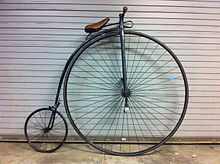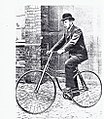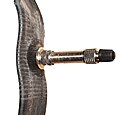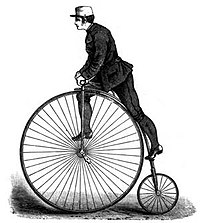History of the bicycle


The year 1817, in which the Baden forestry officer Karl von Drais presented his walking machine , can be assumed to be the beginning of the history of the bicycle . Drais' merit was to have added a steering device to the non-steerable wheels that were already known in the previous century. The most important steps in the development of today's bicycle were
- the addition of the crank drive by the French Pierre Michaux in 1861/63
- the design as a safety low wheel by the Englishman John Kemp Starley in 1885 and
- the invention of the pneumatic tire by John Boyd Dunlop in 1888.
The high wheel , which was stimulated by the crank drive and was mainly used as sports equipment for two decades, was finally replaced by the general purpose safety low wheel . The latter became the standard bicycle used today. It has a diamond-shaped frame ( diamond frame ) and two wheels of the same size and is driven by pedals arranged between the wheels via a chain on the rear wheel.
"It is a peculiar fact in the history of the bicycle that almost all improvements had to be invented two and sometimes three times before they were generally used."
etymology
In the 1880s, the terms "Velociped" or "Bicycle" or "Tricyle", which were taken over from the French and English languages , were still common. However, after the founding of the German Empire, there were great efforts to Germanize foreign words. Hermann Dunger's suggestion "Reitrad" from 1882 could not be accepted. The amalgamation of the various “Velociped” - and, for the first time since 1884, “Radler” clubs, was called the German Cyclists Association after discussions about names when it was founded in 1884 and in 1885 introduced the name “Bicycle”. Otto Sarrazin took over the word in his German translation dictionary from 1886 , which was also influential among the authorities . In 1900, "Fahrrad" was first included in the Duden .
Names previously used in Germany were:
- 1817: Running machine or draisine ( French vélocipède / Draisienne ; English velocipede / Draisine ) The name was retained in the four-wheeled railroad draisine .
- 1860s: Velociped (French: vélocipède )
- 1880s: High safety two-wheeler (including Kangaroo , Star-Bicycle ).
- 1890s: Low safety two-wheeler.
In the English-speaking area:
- 1817-1820: Hobby-horse
- 1868–1872: Boneshaker or velocipede
- 1870-1892: Ordinary or penny-farthing for Hochrad
- Since 1884: Safety
common.
prehistory
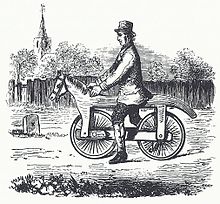
Muscle cars
Muscle cars, etc. a. Helepolen are known from ancient times. Around 1420 Giovanni Fontana drew a four-wheeled cart that was driven by a cable and drum mechanism. In 1649, Hans Hautsch made a mechanically powered car for Karl X. Gustav , and a second for Friedrich III. In 1655 Stephan Farfler developed a small wagon with a hand crank drive. In 1690 Elie Richard from La Rochelle designed a touring car with a crank drive. In the 1840s, Willard Sawyer manufactured a quadricycle with a crank, and in the early 1880s, dicycles were briefly popular.
Non-steerable walking machines
- On the Luxor Obelisk from the 13th century BC A man is shown sitting on a support beam that is connected to two wheels running one behind the other.
- 640 - Rabi ibn Zijad is nicknamed “the machine rider” because he invented a small wagon that you could drive on as if you were sitting on a camel.
- The first half / middle of the 18th century existed the “Nuremberg walking machines”, which were located in the Germanic National Museum in Nuremberg until the end of the 1890s and are said to have consisted of “two clumsy wooden wheels standing one behind the other and connected by a back”.
- 1791 - The unguided Célérifère of the Count de Sivrac. Its existence is controversial, but it cannot be ruled out, for example because of the reference that an operetta entitled Les Vélocifères by Emmanuel Dupaty with wooden two-wheelers was premiered on March 19, 1804 in the Théâtre du Vaudeville .
Two-wheelers allegedly dated before 1817
The following list contains errors, falsifications or unsecured references to earlier two-wheelers.
- 1492 - The Leonardo bicycle in the Codex Atlanticus is a forgery made after 1961 on sheet 133 of the Codex.
- 1642 - The stained glass windows of St Giles Church in Stoke Poges ( Buckinghamshire ) from the time of Oliver Cromwell showed a cherub on a bicycle; the window was destroyed during the war and the current, restored window shows a unicycle.
- 1760 - A running machine with parallelogram steering found in Braunsbedra , which was attributed to the local Wagner Michael Caßler (1733–1772), is more recent and comes from France around 1820.
- 1779 - Jean-Pierre Blanchard and Mefurier presented Louis XVI. a kind of tandem in Versailles . The drivers sat one behind the other, "the one in front was mainly responsible for the controls, the one behind mainly generating the driving force."
- 1801 - The bicycle of the Russian Yefim Artamonov from Yekaterinburg , who is said to have ridden it from the Urals to Moscow, had the characteristics of the Michaulinen.
St Giles Church (built 1642) in Stoke Poges (drawing from Herbert Duncan : The World on Wheels (1926)) wrong!
Drais' walking machine (1817)
On June 12, 1817, Karl von Drais drove for the first time with the two-wheeled running machine he had developed from Mannheim to the Schwetzinger Relaishaus (now in the Rheinau district of Mannheim ) and back, reaching a speed of 13 to 15 km / h. On July 28, 1817, the so-called "mountain trip" from Gernsbach to Baden-Baden followed in the Black Forest with an altitude difference of over 200 meters. Drais completed it twice as fast as a pedestrian. The walking machine weighed less than 50 pounds , little more than a Dutch bike today. It had wooden wheels of the same size with iron tires, a drag brake acting on the rear wheel, parking supports that could be folded down at the front or, alternatively, panniers and an optional luggage rack behind the seat. Lubricated sliding bearings in brass bushings ensured smooth running. In a newspaper article, Drais also described possible custom-made designs for his walking machine. The news about the impeller spread quickly in Germany and Europe; Replicas were made everywhere.
Road quality
In England, France and southwest Germany, thanks to the invention of the macadam , a dense network of country roads existed as early as the first third of the 19th century that was easy to roll along on wheels. The expansion of this network to the northeast took several decades. Until then, in other areas, including large parts of the German Confederation , there were almost only unpaved country roads or roads of a coarser type ( cat pavement made of field stones).
Push stick wheel
- 1817: Johann Carl Bauer suggested a push stick-driven tricycle in his technical improvement of the Drais impeller.
- 1850: The blacksmith Heinrich Färber from Künzelsau built a push stick wheel in which two sticks were moved with the arms to push off the ground and steered with the feet. Depending on the source, it was not presented to the public until 1859 or 1869.
Crank wheel
- 1825 (?) / 62: Baader crank wheel .
- 1845 (?): Heinrich Mylius from Themar is said to have built the first crank wheel.
- 1853: Philipp Moritz Fischer attached a crank to the front wheel of a handcar.
- 1861/63: Pierre Michaux and his son Ernest built a crank wheel with wooden wheels with iron tires and a weight of around 25 kg. In 1865 400 Michaulines were already made. The Michaulinen are the first bicycles to be manufactured in large numbers.
- 1866: Pierre Lallement (Michaux employee) patented a bicycle with a crank drive in the United States .
Baader crank wheel (1825? / 62)
Pedal crank by Heinrich Mylius (1845?)
Pedal crank by Philipp Moritz Fischer (1853)
U.S. Patent No. 59915 issued November 20, 1866 to Pierre Lallement
Michauline (1867)
High wheel with wooden spokes (1867)
The Compagnie Parisienne of the Olivier brothers (after the takeover of Michaux), who vigorously promoted the new sport for young men, built a modified wheel with a wrought iron frame in series in 1867, weighing 40 kg, twice as heavy as the running machine. By twisting the pivoted handlebar, the drag brake on the rear wheel was activated via a brake cord . The saddle was now so high that you couldn't reach the ground with your feet. To get on, you took a run and then straddled the saddle, or someone had to hold the velocipede. Only later was there a footrest for getting on. You couldn't use a pedal for this, as the pedal crank was rigidly connected to the front wheel. Races were driven, the first hand-ground ball bearings were used. The Paris demand was also supplied by British companies in Coventry. There was a brief boom in the US with over a hundred patents. In Germany there were at least 37 manufacturers from 1868, including such well-known names as Heinrich Büssing , who later founded a bus factory. In 1869, a ball bearing was used in the wheel axle for the first time ; before that, plain bearings made of cast bronze were used . The use of solid rubber tires by the Hanlon brothers (1879) was a next step to reduce vibrations.
High wheel with steel spokes (1871)
Edward Alfred Cowper developed a bicycle with tangential spokes as early as 1868 (patent no. 3886 of December 21, 1868). At the same time in England, James Starley , a technology-loving manager of a sewing machine factory, got his hands on a Michauxrad and found it too heavy and unwieldy. He developed an epoch-making new bicycle model, which was offered as "Ariel" from September 1871. It had solid rubber tires with wire spokes. By arranging the spokes tangentially and not radially, the spokes only transmitted tensile forces between the hub and the wheel rim. Twisting the rim with respect to the hub by means of two levers inside served to pretension the spokes. The main disadvantage was that the spokes loosened when kicking downhill. If you accidentally installed the front wheel upside down, it would even collapse when you pedaled or when you operated the tire brake. This deficiency was remedied by the crossed tangential spoke wheel from Starley's patent 3959 from 1874 by clamping the spokes in pairs in opposite directions. Half of the spokes pulled the wheel rim forwards or backwards opposite the hub.
The front wheel of the Ariel wheel was 50 inches (127 cm) in diameter, significantly larger than the Michaulinen up to then with 90 cm and the rear wheel was significantly smaller at 14 inches (35 cm). At the World Exhibition in Paris in 1871, Starley showed a high-performance bike with a front wheel diameter of 2.50 m, which was intended to prove to customers that wire spokes were doubtful.
Before James Starley, the French Eugène Meyer patented the steel spoke wheel (French patent no. 86705 of August 4, 1869). Meyer wrote in the patent: "Since all wire spokes are only subjected to tension here, they cannot kink" and used it to build elegant crank bicycles - with increasingly smaller rear wheels, like other French manufacturers. The spokes still have the same shape today, but were installed radially and vice versa - hung on the rim and screwed into the hub.
High safety wheel (1878)
To reduce the risk of accidents, especially the dreaded head falling off the unicycle to prevent the development of a "safety" or "safety bicycle" was driven by the English bicycle industry. Harry John Lawson had the term “safety” protected as early as 1876 in connection with the development of the safety bicycle . The first high safety bike was the Xtraordinay by Singer (1878), followed by the “Facile” by Ellis (1879) and finally the Kangeroo (1884) by Edouard Carl Friedrich Otto . In all cases, the size of the front wheel was reduced and the driver's center of gravity shifted towards the rear wheel. While the first two models were moved using pedal levers, the Kangaroo already had a chain drive.
Rear wheel drive
- 1839: Kirkpatrick Macmillan developed the first bicycle with rocker arm drive on the rear wheel.
- 1843: Alexander Lefebvre from Saint-Denis built a rocker arm.
- 1846: Gavin Dalzell rebuilt Macmillan's bike.
- 1860: Thomas McCall made replicas of Macmillan's wheel.
- 1876: Henry John Lawson developed the Safety Bicycle , a bike with a pedal drive on the rear wheel.
- 1878: Thomas Shergold designed a safety bike with wheels of the same size, a bizarre frame shape and chain drive on the rear wheel.
- 1879: Henry John Lawson developed the Bicyclette , a bicycle with a cross frame and chain drive on the rear wheel. The wheels were different, the front wheel with parallelogram steering was larger.
- 1879: André Guilmet and Meyer & Cie presented rear-wheel drive on a bicycle in Paris.
- 1879: The Stuttgart gymnastics teacher Johann Friedrich Trefz designed a bicycle with a pedal crank drive on the rear wheel.
"The perfect rear-wheel drive was invented, but in the shadow of the Michaux series production of front-wheel drive wheels, which has now started, it could not prevail."
- 1881: Star bicycle with pedal drive.
Kirkpatrick Macmillan's pedal wheel (1839)
Lawson's Safety Bicycle (1876)
Lawson's Bicyclette (1879)
Johann Friedrich Trefz ´ crank wheel (1879)
Star Bicycle (1885)
Safety low wheel (1885)
The breakthrough of the chain-driven rear wheel was achieved by John Kemp Starley , grandson of James Starley, who initially produced three-wheelers in Coventry together with his business partner William Sutton. In 1884 Starley developed under the brand name Rover ("Wanderer") his first two-wheeler with chain drive on the rear wheel, indirect steering and block brake on the front wheel. Like Lawson's design, it still had wheels of different sizes: 32 inches on the front wheel, 30 inches on the rear wheel. Weighing in at 37 pounds (16.7 kg), the Rover was barely heavier than today's touring bikes. The public was so fixated on the penny farthing that visitors to the first presentation described the rover as unsporting. Starley then organized a race on September 26, 1885, in which the speed of his vehicle was demonstrated with a new, significantly improved vehicle, the Rover II . George Smith won the 100 mile race on the Rover II (33 pounds light) in 7 hours, 5 minutes and 16 seconds. In 1886 Starley produced the Rover III with neck control , which is considered the prototype of the modern bicycle. In 1889 the “Ladies Rover” model appeared, a bike with a deep step-through; this allowed women to take part in cycling.
John Kemp Starley (1888) with Rover III
Pneumatic tires (1888)
The reinvention of the pneumatic tire (GB Patent No. 10607 of October 31, 1888) and bicycle valve by John Boyd Dunlop - after the invention of Robert William Thomson (1845) had been forgotten - was soon successful in sporting terms. The second-rate racing driver William Hume beat the best racing drivers on their solid rubber tires in a bicycle race on May 18, 1889 in Dublin . Another milestone was the British patent no. 14563 dated September 16, 1890, by Charles Kingston Welch . Welch's patent described a clincher tire with a tube that was mounted on a drop center rim. In addition to this patent, Dunlop's Pneumatic Tire Company acquired the patent on bead strips ("clincher" or "heel tire") from William Erskine Bartlett ; the first Dunlop tires were still glued to the rim. In 1890 there were already the first series bikes with Dunlop tires. In 1891, Charles Terront won the Paris – Brest – Paris cycle race with a newly developed Michelin tubular tire that was also removable . In 1894, 89.5 percent of all new bicycles were fitted with pneumatic tires.
Adler solid rubber tires (1886)
The modern bicycle
As early as 1884, the “Rover” model had a tubular frame that resembled a diamond. Thomas Humber developed the direct connection between saddle and bottom bracket through a (straight) tube ( diamond frame or pentagonal frame ) in 1890. The development of the modern bicycle was almost complete. The first bicycle dynamo (1886) by Richard Weber had already been invented, patents for the rim brake were issued in 1889, and in the same year the chainless bicycle with shaft transmission to the rear wheel from Fabrique Nationale Herstal . In 1893, the St. Louis Refrigerator and Wooden Gutter Co. introduced bicycles with aluminum frames under the brand name Lu-Mi-Num . In 1894 a bamboo bicycle appeared . The hub gears were added in 1895 and the torpedo freewheel hub with coaster brake in 1903 . In 1908 Fritz Eichert developed today's bicycle dynamo, which was sold under the “Berko” brand. The chair wheel or J-wheel by Paul Jaray (1921) is considered to be the forerunner of the recumbent bike . With the introduction of derailleur gears by Campagnolo (1946), sprocket packs and thus different gear ratios for different routes were possible. The folding bike of Alex Moulton (1960) had already military predecessors. After the Bonanzarad (1963) became fashionable, off- road cycling became popular with the BMX bike (1972).
With the introduction of electrically powered bicycles, the pedelec (1995), the average speed and the range of action of the rider were increased compared to conventional bicycles.
historical development
Picture panels
Pictures from 1890:
| year | model | description |
|---|---|---|
| 1884 |  |
The "Kangaroo", a penny-farthing bike from Hillman in Coventry, reduced in height to 91 cm, with a chain drive on both sides on the front wheel |
| 1885? | 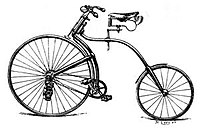 |
The "Jupiter" by C. Bescherer in Zeitz on the way to the Niederrad. |
| 1886 |  |
The "Juno" safety bike from Metropolitan Machinists' Co., London with a cross frame. |
| 1888? |  |
Niederrad with a forerunner of the diamond frame from Frankenburger & Ottenstein in Nuremberg (seat tube was initially missing) |
Development of the impellers
| Brand name or manufacturer |
Construction year | Front wheel in inches |
Rear wheel in inches |
Type of tires | Number of spokes (larger wheel) |
image |
|---|---|---|---|---|---|---|
| Draisine | 1817 | 24 | 24 | Iron band on a wooden wheel | 8th |
|
| Michauline | 1867 | 36 | 32 | Iron band on a wooden wheel | 12-18 |
|
| Ariel high bike | 1871 | 50 | 14th | Solid rubber on steel rim | 40 |

|
| Star Bicycle | 1881 | 20th | 55 | Solid rubber on steel rim | 60 |
|
| Kangaroo | 1884 | 36 | 14th | Solid rubber on steel rim | 40 |
|
| Rover III | 1886 | 30th | 30th | Solid rubber on steel rim | 34 |
|
| Rover Lady's Safety | 1889 | 28 | 26th | Solid rubber on steel rim | 34 |
|
| Crypto | 1892 | 44 | 16 | tire | 32 |

|
| Humber model B | 1895 | 30th | 28 | tire | 34 |
|
Cycling history organizations
Organizations engaged in research into the history of the bicycle and the proper preservation of all related artifacts are the British Veteran Cycle Club , the German Association of Historic Bicycles. V. , the US wheelmen and other national and also smaller clubs.
The International Cycling History Conference (ICHC) has met in a different country every year since 1990 . Your conference reports "Cycle History" offer the opportunity to get an overview of the current state of knowledge.
Periodic publications are related to the clubs, except for the "Vintage Bicycle Quarterly" published in the USA.
The bicycle in a social and technical context

Sociologists of technology use the example of the history of the bicycle (such as the history of the air-filled tire ) to show how much technical development processes depend on social expectations and the attribution of meaning. The development of the high-bike is judged in its design as an unsafe two-wheeler, which not only excluded certain people as a driver ("macho bicycle"), but raised them to the same level as a rider due to its seat height.
The use of muscle power improved significantly when the low safety wheel established itself as a vehicle that can be used by everyone. The technology used early on, such as lightweight tubular frames , pneumatic tires and ball bearings , led to a high level of energy efficiency .
“Ball bearings, freewheel hubs, chain drives, air-filled tires [...] are inventions that made history. They were first tested and developed on a bicycle [...]. "
Due to the technical development, bicycle production boomed. The annual production in Germany in 1882 was around 2500 units, in 1897 350,000 units were made. In North America, production was over 1 million pieces at the turn of the century. In 1980 25 million bicycles and today around 78 million bicycles were registered in Germany. More than 100 million bicycles are manufactured worldwide every year, the largest producer is China.
| Types | Years of construction | Built copies |
|---|---|---|
| Draisine | 1817-1819 | ≈ ≤ 100 |
| Michauline | 1863-1870 | ≈ 6125 |
| Penny farthing | 1870-1892 | ≈ 200,000 |
| Safety low wheel | 1885– | ≈ ≥ 1,000,000,000 |
The bicycle in the military
Bicycles were used by the French army as early as the siege of Belfort (1870). The Italians began using bicycles for military purposes in 1878, Hungary in 1884, Germany in 1886 and Belgium in 1888. By 1889 England had 30 battalions with bicycle divisions. Special designs such as foldable or foldable military bicycles followed. During World War I there were cycling troops on different sides . In the Indochina War and the Vietnam War , essential parts of the military transport services by the Viet Cong were carried out by bike. Bicycles were used in the Swiss Army until 2003 . The army of Sri Lanka is said to still have a bicycle department today.
literature
- Carl Johann Siegmund Bauer: Description of the v. Drais' driving machine and some improvements attempted on it, Nuremberg 1817. Reprint: Westhafen Verlag, Frankfurt am Main 2016 (with an afterword by Hans-Erhard Lessing ), ISBN 978-3-942836-09-8 .
- Eduard Bertz : Philosophy of the bicycle , Dresden 1900. Extended new edition: Georg Olms Verlag Hildesheim 2012, ed. v. Wulfhard Stahl, ISBN 978-3-487-08497-8
- Wiebe E. Bijker: Of Bicycles, Bakelites, and Bulbs. Cambridge, Massachusetts Institute of Technology , 1995, ISBN 978-0-262-02376-4 .
- Nick Clayton: Early Bicycles. Shire Publications Ltd., 1994, ISBN 0-85263-803-5 .
- Ludwig Croon: The bicycle and its development. Deutsches Museum , Treatises and Reports. VDI-Verlag, Berlin 1939.
- Anton Daul: Illustrated history of the invention of the bicycle and the development of motorcycles . Creutz publishing house, Dresden 1906.
- Pryor Dodge: the fascination of bicycles. History - technology - development. Delius-Klasing, Bielefeld 1997, 2007, ISBN 978-3-7688-5253-1
- Franz Maria Feldhaus : The technology. A lexicon of prehistoric times, historical times and primitive peoples . Engelmann, Leipzig and Berlin 1914.
- Jutta Franke: Illustrated bicycle history . Nicolaische Verlagbuchhandlung. Berlin 1987. ISBN 3-87584-220-0 .
- Wolfgang Gronen , Walter Lemke: History of cycling. Fuchs-Druck und Verlag, Hausham 1987.
- Tony Hadland & Hans-Erhard Lessing: Bicycle Design - An Illustrated History . The MIT-Press, Cambridge (USA) 2014, ISBN 978-0-262-02675-8
- Hans-Erhard Lessing : Automobility - Karl Drais and the incredible beginnings . Maxime-Verlag, Leipzig 2003, ISBN 978-3-931965-22-8
- Hans-Erhard Lessing: The bicycle. A cultural story. Klett-Cotta, Stuttgart 2017, ISBN 978-3-608-91342-2 .
- Hans-Erhard Lessing: How Karl Drais invented the bicycle . Lauinger-Verlag, Karlsruhe, 2017 ISBN 978-3-7650-8431-7 .
- Max JB Rauck, Gerd Volke, Felix R. Paturi: By bike through two centuries. The bicycle and its history . 4th edition. AT Verlag, Aarau u. a. 1988, ISBN 3-85502-038-8 .
- Rüdiger Rabenstein : Cycling and Society . Olms-Weidmannsche-Verlagsbuchhandlung, Hildesheim 1995, ISBN 978-3-615-00066-5
- Andrew Ritchie: King of the Road. Wildwood House, London 1975, ISBN 0-913668-42-7 .
- Paul von Salvisberg : Cycling in pictures and words. Munich 1897 (Reprinted by Olms 1980, ISBN 978-3-487-08216-5 )
- Peter Schneider: The two-wheeler through the ages . German Two-Wheeler Museum Neckarsulm . 1980
- Wilhelm Wolf: Bicycle and Cyclist. Leipzig, 1890, Dortmund (3rd reprint), 1988
- John Woodeford: The Story of the Bicycle. Routledge & Kegan, London 1970, ISBN 0-7100-6816-6 .
Web links
Individual evidence
- ↑ Max Rauck et al. a .: By bike through two centuries. P. 20: The trolley becomes popular.
- ↑ Ludwig Croon, p. 167.
- ^ Hermann Dunger : Dictionary of Germanizations of dispensable foreign words. BG Teubner, 1882. Quoted from: Hans-Erhard Lessing: Das Fahrrad. A cultural story. , P. 124.
- ^ Hans-Erhard Lessing: The bicycle. A cultural story. P. 125.
- ^ Johann-Günther König: Cycling. From the draisine to the e-bike. Reclam, Stuttgart 2017, ISBN 978-3-15-011098-0 , p. 7.
- ↑ Fahrrad, das. In: Duden.de. Bibliographisches Institut GmbH, accessed on January 3, 2018 .
- ^ The running machine of Baron Karl von Drais. Mannheim 1817 (Reprint Technoseum Mannheim 1993)
- ↑ Hans-Erhard Lessing: Karl Drais. P. 78.
- ^ Hans-Erhard Lessing: Automobility. P. 490.
- ^ Wilhelm Wolf: Bicycle and cyclist. P. 97.
- ^ Wilhelm Wolf: Bicycle and cyclist. P. 104.
- ↑ Nick Clayton: Early bicycles , p. 4.
- ↑ Max Rauck et al. a .: By bike through two centuries. P. 10 f.
- ^ Franz Maria Feldhaus: The technology. P. 1267.
- ↑ How Richard's car works
- ↑ Gronen and Lemke, p. 9.
- ↑ Gronen and Lemke, p. 13.
- ^ Franz Maria Feldhaus : The machine in the life of the peoples. 1954, ISBN 978-3-0348-4025-5 , p. 166.
- ^ Wilhelm Wolf: Bicycle and cyclist. P. 14 f.
- ↑ Max Rauck et al. a .: By bike through two centuries. P. 14.
- ↑ Max Rauck et al. a .: By bike through two centuries. P. 13.
- ↑ Hans-Erhard Lessing: The burden of proof against "Leonardo's bicycle". In: Mannheim history sheets. NF5 (1998), pp. 345-357.
- ↑ The Leonardo da Vinci Bicycle Hoax on pryordodge.com
- ↑ Gronen and Lembke, p. 17.
- ↑ Stained glass window in Stoke Poges
- ↑ Max Rauck et al. a .: By bike through two centuries. P. 28.
- ^ Caßler wheel
- ^ Wilhelm Wolf: Bicycle and cyclist. P. 9.
- ^ Wilhelm Wolf: Bicycle and cyclist. P. 33.
- ↑ Max Rauck et al. a .: By bike through two centuries. P. 21.
- ↑ The first trip on June 12th was only reported together with the ascent in the Baden-Badener Badwochenblatt on July 29th, 1817 ( digitized version ). See Lessing: Karl Drais. Two wheels instead of four hooves . Braun, Karlsruhe 2010, ISBN 978-3-7650-8569-7 , p. 52.
- ^ Hans-Erhard Lessing: Automobility. P. 140.
- ^ Hans-Erhard Lessing: Automobility. Pp. 150-155.
-
↑ Texts on road construction in various German states in the Historical Geographic Information System ( HGIS ( Memento of the original from December 31, 2013 in the Internet Archive ) Info: The archive link was automatically inserted and not yet checked. Please check the original and archive link according to the instructions and then remove this note. ) and other sources:
- HGISG: Baden ( Memento from November 11, 2013 in the Internet Archive )
- HGISG: Württemberg (pages 5 and 6; PDF; 43 kB)
- HGISG: Prussia ( Memento from November 11, 2013 in the Internet Archive )
- Prussian road construction policy under pressure to decentralize (PDF; 2.6 MB)
- Road construction in Schleswig-Holstein 1830–1882 ( Memento from November 11, 2013 in the Internet Archive )
- ^ Carl Johann Siegmund Bauer: Description of the v. Drais'schen driving machine and some attempts to improve it. Nuremberg 1817. Reprint: Westhafen Verlag, Frankfurt am Main 2016, ISBN 978-3-942836-09-8 , p. 66.
- ↑ Walter Euhus : The Künzelsauer push rod wheel. In: The bone shaker. Magazine for lovers of historic bicycles. Issue 31, 2/2004, Langenhagen 2004, p. 19.
- ↑ Ingo Gabor et al .: Lust for history - selected moments from the Künzelsau past. The Künzelsau Municipal Collection visits the Hirschwirtscheuer. Swiridoff, Künzelsau 2005, ISBN 3-89929-059-3 , p. 56 f.
- ^ Jürgen Hermann Rauser: Ingelfinger Heimatbuch. 1. Book City History. Heimatbücherei Hohenlohe Volume 2, Ingelfingen 1980, p. 268.
- ↑ fahrzeug-museum-suhl.de The first pedal crank bicycle in Germany. (accessed on July 20, 2017)
- ↑ Gronen and Lembke, p. 41.
- ^ Franz Maria Feldhaus: The technology. P. 274.
- ↑ Ludwig Croon, p. 168.
- ↑ Peter Schneider: The two-wheeler through the ages. P. 13.
- ↑ Max Rauck et al. a .: By bike through two centuries. P. 37.
- ↑ Max Rauck et al. a .: By bike through two centuries. P. 39.
- ^ Matthias Kielwein: Velocipede in Germany. In: The bone shaker. No. 37 (2006), pp. 2-7.
- ↑ Max Rauck et al. a .: By bike through two centuries. P. 120.
- ^ A b Nick Clayton: The Development of the Suspension Wheel
- ↑ Max Rauck et al. a .: By bike through two centuries. P. 47.
- ↑ Nick Clayton: "Who invented the Penny-Farthing?" In: Cycle History. No. 7, San Francisco 1997, pp. 31-42.
- ^ John Woodforde, p. 60.
- ↑ Max Rauck et al. a .: By bike through two centuries. P. 30.
- ↑ Alexander Lefebvre
- ↑ Daul, p. 7.
- ↑ Shergold's bicycle, 1878
- ^ Lawson Bicycle, 1879
- ^ Franz Maria Feldhaus: The technology. P. 274.
- ↑ Max Rauck et al. a .: By bike through two centuries. P. 67.
- ^ Tricycle from March 20, 1883
- ↑ John Woodforde. P. 96.
- ↑ Andrew Ritchie. P. 130.
- ↑ Rover II
- ↑ Max Rauck et al. a .: By bike through two centuries. P. 69 f.
- ^ Rover I, II, III
- ↑ U.S. Patent 455899, July 14, 1891
- ^ Wiebe E. Bijker, p. 80.
- ↑ Peter Schneider: The two-wheeler through the ages. P. 85.
- ↑ Max JB Rauck, p. 108.
- ^ Wiebe E. Bijker, p. 83.
- ↑ Peter Schneider: The two-wheeler through the ages. P. 85; Max Rauck et al. a .: By bike through two centuries. P. 115.
- ↑ U.S. Patent 635669
- ^ Tony Hadland, Hans-Erhard Lessing: Bicycle Design. An Illustrated History. P. 395.
- ^ Jutta Franke: Illustrated bicycle history. P. 98.
- ^ Wilhelm Wolf: Bicycle and cyclist.
- ↑ Information from the literature: If the figures differed, either the average size or the best-selling model was used.
- ^ International Cycling History Conference
- ↑ Vintage Bicycle Quarterly
- ↑ Trevor Pinch, Wiebe Bijker: The social construction of facts and artifacts: Or how the sociology of science and the sociology of technology might benefit each other. In: Wiebe Bijker, Thomas Hughes, Trevor Pinch (eds.): The social construction of technological systems: New directions in the sociology and history of technology. MIT Press, Cambridge 1987, pp. 17-50 ( digitized ); Martina Heßler: Cultural history of technology. Campus Verlag, 2012, ISBN 3-593-39740-4 , p. 101.
- ^ Wiebe E. Bijker, pp. 75, 297.
- ↑ Peter Schneider: The two-wheeler through the ages (foreword).
- ^ Paul von Salvisberg: The cycling sport in pictures and words. P. 216.
- ↑ Peter Schneider: The two-wheeler through the ages. P. 20.
- ↑ Cycling in numbers
- ↑ Ludwig Croon, p. 182.












